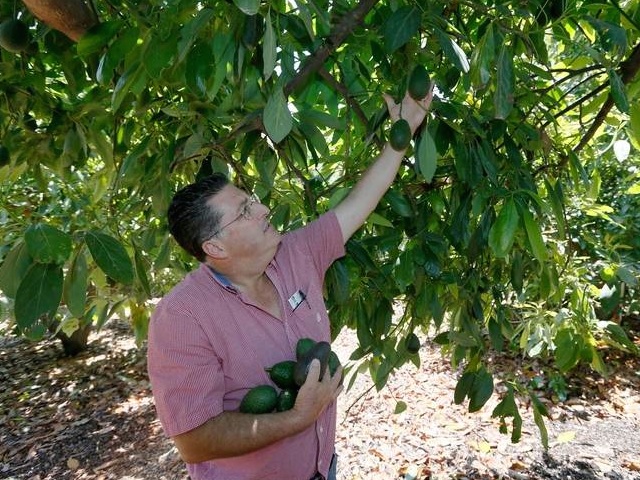Daily Business Report-Oct. 8, 2015
An avocado farmer in San Diego County. avocados, which have been greatly affected by drought and water prices, dropped 22 percent in value last year.
Decline in County Crop Production Blamed
On Drought and Rising Cost of Water
The total value of San Diego County’s agricultural production decreased in 2014 for the first time since 2009 — from $1.85 billion in 2013 to just under $1.82 billion — according to the annual crop report released by the county Department of Agriculture, Weights and Measures.
The total number of acres in production also dropped — by 12.1 percent — the largest decrease in 18 years.
Eric Larson, executive director of the San Diego County Farm Bureau, said there was even a bright side to the 1.77 percent decrease in total agricultural value, coming after four straight years of increase.
“The slight drop in production value comes as no surprise in light of the challenges faced by farmers from the drought and the rising cost of water,” Larson said. “In fact, the change is small enough to be seen as a testament to the resolve of farmers to overcome the water issues.”
San Diego County Agricultural Commissioner Ha Dang said that resolve blended well with the county Board of Supervisors’ commitment to agriculture both as an industry and a way of life.

“Our growers continue to find effective ways to address challenges like the drought and invasive pests,” Dang said. “And the Board of Supervisors continues to support them, promoting and encouraging agriculture. That combined effort contributes to the sustainability of San Diego County’s thriving agricultural community and environment.”
The Crop Report, which can be seen online, stated that each of the top three crops — ornamental trees and shrubs; indoor flowering and foliage plants; and bedding plants, color and herbaceous perennials — increased in value in 2014.
The fourth most valuable crop, avocados, which has been greatly affected by drought and water prices, dropped 22 percent in value.
Wine grape values, which in 2012 saw a huge boost in interest and a 512 percent increase in value, increased by a modest .88 percent in 2014 to roughly $6.6 million. However, acres in production jumped 9.6 percent to 923 acres — capping a 121 percent increase in acreage since 2011.
Cacti and succulents, meanwhile, jumped 64 percent in value, from roughly $26.5 million in 2013 to $43.4 million in 2014.
Among other highlights from the report:
• San Diego County continues to have more farms than any other county in the nation with 5,732.
• Nearly 19 percent of those farms are run by women.
• San Diego County has the 20th largest agricultural economy in the U.S.
• Strawberries posted the biggest percentage increase in value from 2013, 16.2 percent.
Faced with skyrocketing water prices and an uncertain supply, avocado farmers in San Diego County, long the nation’s top avocado-producing region, are uprooting their trees in favor of more water-efficient crops, according to a report in the Wall Street Journal. Many are growing grapes and getting licenses to operate wineries. Others are replacing avocado trees with exotic flowers or specialty fruits that they can hawk at local farmers markets.
_________________________________________________________

Target Opens New South Park Store
There were no protesters in sight Wednesday morning when the new TargetExpress store opened at 8 a.m. on Grape Street in South Park after months of preparation and critical comments from some in the community.

Wearing a smile, store manager Robert Farrington, 30, said he didn’t notice anyone objecting to the store — just a bunch of people waiting to get inside.

During the opening day, the 90-space parking lot in front of the former Gala Foods store filled to capacity. Inside the store, customers milled about the several aisles, many lining up at the cashiers’ stations with goods to purchase.
People drifted in and out of the store’s aisles, looking at the various stations that the Target Corporation assembled after a full year of market research into what the community’s desires were.
The store offers a variety of products including hardware items, a pharmacy — the first in South Park — organic produce, a mix of Target brand items, a toy section, wine and beer selections, a photo booth, a tech aisle, clothing, health and beauty products, among others.
But no Starbucks.
Judging by comments by some of the customers, the Target store did its due diligence. “I like it a lot. We needed this,” said Margot Howard, shopping for a Halloween costume mask.
Another shopper, Claudia Kellersch, brought son Alexander, 9, to the store to look around. Their shopping basket was getting full.
New Target to Open in Del Sur
Times of San Diego
Target will open a 143,000-square-foot store Sunday at the Del Sur Town Center, a new specialty retail and dining development serving the communities in the Black Mountain Ranch master plan area.
The Target store will anchor the center and include general merchandise, fresh food, a Starbucks, pharmacy, clinic and optical department.
The center also offers 67,000 square feet of additional retail that includes a specialty grocer to be announced and 39,000 square feet of retail, dining and services.
“We couldn’t be more excited about the opening of Target at Del Sur Town Center,” said Kevin McCook, vice president of acquisitions and development at Shea Properties, which is developing the center. “Target will, without a doubt, establish Del Sur Town Center as the hub of this community.”
Shea Properties, headquartered in Aliso Viejo, is a diversified real estate company developing apartment communities, shopping centers, business parks, and mixed-use environments.
SANDAG Board to Weigh $204B
Final Regional Plan on Friday
The SANDAG board of directors on Friday will consider adopting the $204 billion final regional plan, which would commit more than 50 percent of its investment to transit — including five new Trolley lines, 32 new Rapid lines and a big increase in transit frequencies.
The vote comes after more than two years of public meetings and technical study.
The plan — officially known as San Diego Forward: The Regional Plan — is a big picture vision for the region’s future combined with a specific plan for building $204 billion worth of transportation infrastructure between now and 2050 to help make that vision a reality.
“This plan relies on adding layers of transportation choice,” said SANDAG Chair and Santee Councilmember Jack Dale. “By growing within our existing communities — then connecting those communities with not just freeways, but with carpool lanes, transit services, bikeways, and safe walking routes — we can achieve all of our goals.”
By 2050, the region is expected to be home to a million more people than it is now, half a million more jobs, and 300,000 more homes. In anticipation, city and county land use plans have changed to focus most forecasted growth in already existing communities. The Regional Plan responds to those new land use patterns, overlaying more transportation choices to connect communities with different modes of travel.
Overall, the plan:
• Dedicates 15 percent of its resources to add 160 miles of Managed Lanes to our existing freeways for the specific purpose of allowing transit, carpools, and vanpools to be more efficient and bypass traffic.
• Directs more than $588 million to building 275 miles of bikeways, making active transportation a realistic alternative to car travel for more people.
• Invests a total of $4.9 billion in active transportation improvements throughout the region, including biking and walking improvements, such as upgrades to freeway overpasses.
Friday’s meeting will begin at 10 a.m. in the SANDAG board room on the seventh floor of 401 B Street in Downtown San Diego.
Emida Buys San Diego-Based
Quippi and its Gift Card Business
Emida, an Orange County company that specializes in serving the global prepayment industry, said it is acquiring Quippi, a San Diego startup that offers pre-paid gift cards in Mexico as a no-fee alternative to international money transfers.
Financial terms of the deal were not disclosed. Quippi founder Michael Aleles declined to even tell me how many employees Quippi has today (less than 10, according to LinkedIn; eight, according to CrunchBase), saying he is bound by a confidentiality agreement with Emida.
Quippi has raised at least $3 million since it was founded in 2012, including $2.2 million in a Series A round from San Diego-based Avalon Ventures and Accion, the New York microfinance lender.
As Xconomy reported early last year, Quippi began selling its gift cards in the last three months of 2013. Today, Quippi gift cards purchased in the U.S. can be used to buy merchandise at over 4,800 retail stores in Mexico, including stores operated by Coppel, Chedraui, Farmacias Benavides, Office Depot Mexico, Construrama, FarmaTodo, and Opticas Devlyn. (Under Quippi’s business model, consumers pay only the face value of the card, and Quippi is paid by the retailers to provide the cards.)
The New Children’s Museum Receives
$50,000 Grant From Target Corporation
The New Children’s Museum has been awarded a $50,000 grant from Target Corporation to fund discounted museum admission one Sunday per month.
The grant funds the Museum’s Target Dollar Second Sundays, allowing families to enjoy the museum and eliminating cost as a barrier. This is the 6th consecutive year Target has provided funds to the museum.
“Thanks to the continued generosity of Target, The New Children’s Museum is able to provide children and families with the opportunity to explore creativity at very little cost to them,” said Tomoko Kuta, director of education and exhibitions. “This grant provides us with a fantastic opportunity to open the museum up to those who might not otherwise be able to experience it.”
Sen. Boxer Introduces Federal Bill
To Curb Reckless Use of Drones
U.S. Sen. Barbara Boxer (D-Calif.) has introduced the Safe Drone Act to address the growing problem of drones jeopardizing public safety by flying too close to wildfires and airports. The bill would make it a misdemeanor offense for an individual to knowingly operate a drone within two miles of a fire, an airport or other restricted airspace.
“Our firefighters and airplane pilots should be focused on keeping the public safe — not worrying about unauthorized drones that recklessly interfere with their jobs,” Boxer said.
The bill follows a series of recent incidents where reckless drone operators have forced firefighting agencies to suspend all air operations out of concern for the safety of the pilots and people on the ground. Nationwide, the U.S. Forest Service has identified 13 different instances this year where drones interfered with firefighting efforts, up from only four the previous year. This year in California, there have been five cases where drones have hindered firefighting efforts.
The bill would allow federal, state, or local agencies and firefighters to use drones in restricted airspace for legitimate purposes, such as surveying the size of a fire.
Congressman John Garamendi (D-Calif.) recently introduced the House version of the bill.
Point Loma Residents Protest
Proposed Flight Path Change
Times of San Diego
Residents of Point Loma are protesting a proposed change in the flight path for aircraft taking off and heading east from San Diego International Airport.
The Federal Aviation Administration wants to remove a waypoint on the flight path as part of a national effort to switch from ground-based to satellite flight control.
The FAA says the change is negligible, but local critics say planes will be able to make a tighter turn to the east and cross the Point Loma peninsula a second time.
Hundreds of residents attended a public meeting on Tuesday, and Rep. Scott Peters has criticized the proposal.
“The community’s concern over the potential for increased air traffic over their neighborhoods is one that I echo and I have called on the FAA not to remove its waypoint at the south end of Pt. Loma,” Peters said.
In a letter to FAA Administrator Michael Huerta, Peters noted that “these residents understand that their properties are adjacent to an airport. However, they were promised that future departure flight paths would not be directed over their homes.”
The FAA report on the proposed route change argues that “there would be no changes in aircraft noise exposure that would exceed the FAA’s significance threshold for noise impacts on people.”
Thursday is the final day for public comments on the proposed change.
Personnel Announcements
Ritterbeck Joins Higgs Fletcher & Mack

Jamie Ritterbeck has joined Higgs Fletcher & Mack as its newest transportation litigation associate. She will assist partner Virginia Price in defending transportation companies in personal injury and cargo litigation.
Prior to joining Higgs, Ritterbeck was an associate at Klinedinst PC. In this role, she represented individuals and entities in all stages of general and complex business as well as commercial and intellectual property litigation.
Before that, Ritterbeck was an associate at Samuelsen, Gonzalez Valenzuela & Brown LLP and represented employers and insurance companies in all phases of litigation.
Other experience includes research assistant to Professor Michael R. Devitt at the University of San Diego School of Law, legal intern at the University of San Diego School of Law Appellate Clinic, judicial extern to the Honorable Nita L. Stormes, U.S. District Court, Southern District of California and judicial extern for the Superior Court of the State of California.
She earned her law degree from the University of San Diego School of Law.



